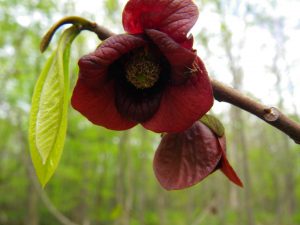
Look for the dark maroon flowers of the pawpaw tree in early spring and dare to take a whiff. It smells like rotting meat. But believe it or not, by September, these foul-smelling flowers will have developed into a delicious, nutritious edible fruit. Dig a little deeper into the history of the pawpaw and you’ll discover even more surprises.
Some have called pawpaw (Asimina triloba) the forgotten fruit. As our largest wild fruit, it was once a cherished food foraged by Native Americans, then by colonists and settlers moving through the eastern United States. But as farms and cities began to replace the forests where pawpaw grow, these wild fruits dwindled in importance.
Not everyone has forgotten about the pawpaw though, and with renewed interest in finding local foods, pawpaw is finding its way back into our lives. Pawpaw trees thrive in rich soils near streams throughout forests of the eastern United States. They grow in many of our Metro Parks, and are easily found on our Greenway trails. You may have heard the term pawpaw patch, which describes the plant’s tendency to send up sprouts from the root, resulting in many trees that come from the same plant. These small, shrub-like trees are a member of the family of plants called Annonaceae. Many plants in this family, such as custard apples, are tropical. Pawpaw is the only known member of this family found as far north as Ohio.
There’s certainly nothing tropical about the climate in Central Ohio. So how did this tropical tree spread its range into Ohio and Ontario, Canada? Scientists have suggested pawpaw were originally dispersed by large mammals, such as ground sloths, before the last ice age. Fossils showing a plant very similar to our current pawpaw were found in Mississippi. After the glaciers receded, it is likely that early Native Americans expanded the ranges of many useful plants, including pawpaw.
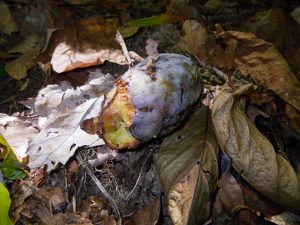
Even if it were humans that helped spread pawpaw as far north and west as they would grow, these plants rely on much smaller critters to produce fruit. In early spring, the downward-pointing wine-red flowers appear before the leaves, among last year’s twigs. These putrid-smelling flowers attract pollinators like flies and beetles. If the flowers are pollinated, pawpaw fruits will develop in clusters. The fruit ripens in fall, usually in September here in Ohio. Wild mammals such as raccoons, opossum, and black bear enjoy the fruits, which are rich in protein and many other nutrients.
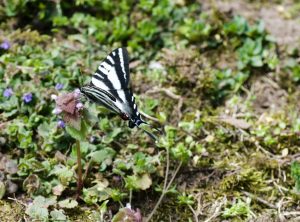
Pawpaw offer more than nectar and fruit to wildlife. If you have been lucky enough to encounter a zebra swallowtail butterfly along the trails, it was because of the huge, oblong-shaped pawpaw leaves. Zebra swallowtail caterpillars feed on these tropical-looking leaves, which are usually around a foot long. Another insect, a moth called a speckled talponia, feeds on pawpaw flowers while in the larval caterpillar stage. Most plants have developed ways to protect themselves from being eaten, and pawpaw is no different. There are chemicals in the pawpaw plant that can be harmful, but these insects have developed ways to deal with the toxins.
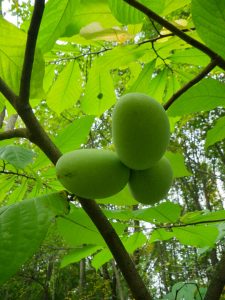
As the largest edible fruit indigenous to the United States, it’s not hard to see why it was useful to Native American tribes. A pawpaw tree could provide plenty of fruits for eating, while the inner bark of the plant could be used to make rope. The name pawpaw was coined by Hernando de Soto in 1541 during an expedition to the lower Mississippi valley. Noticing the fruit’s resemblance to papayas from the Caribbean, he borrowed the Arawakan name for papaya fruits, pawpaw, although in fact the two fruits are unrelated. Presidents George Washington and Thomas Jefferson were both said to have enjoyed pawpaws. And this fruit can even be credited for saving the expedition of Lewis and Clark, who dined on pawpaws on their 1806 return voyage when their food supplies were drastically low.
How did a fruit once enjoyed by US presidents fall into obscurity in Ohio, where it grows naturally? The answer lies in the pawpaw’s short shelf life, which makes selling the fruit difficult. Pawpaw was not developed for production as other non-native fruits were. But in recent years, there has been an ebb and flow of pawpaw popularity. In the 1960s, a resurgence of eating naturally came into vogue, helping to bring native plants like pawpaw into the spotlight. Euell Gibbons’ cookbook, “Stalking the Wild Asparagus” (1962) includes a recipe for making a parfait out of papaw.
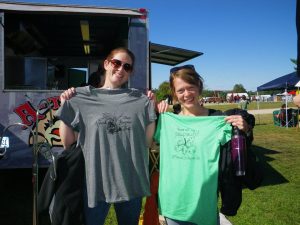
The pawpaw has recently become more popular with those who enjoy native fruits and is sold commercially by nurseries who highlight their use as a wonderful shade tree. Pawpaw enthusiasts have created festivals to celebrate the fruit in Kentucky and North Carolina. More locally, the Ohio Pawpaw Festival is in its 17th year and is happening Friday through Sunday, Sept 16-18. Many people do not realize that the pawpaw was designated as Ohio’s state native fruit, signed into state history in 2009 by Governor Ted Strickland. However, the pawpaw is still obscure to many, as an internet search for pawpaw brings up many photos of papaya fruit.
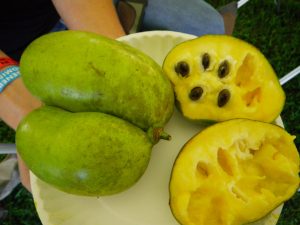
People have a variety of responses to the taste, which also depends on the ripeness of the fruit. Pawpaws have many fans but some dislike the taste and others are even allergic. Pawpaw fruits have a custard-like consistency and taste ranges from mango to banana to indescribable. Regardless of taste, pawpaw fruits do have many human benefits, and pack a nutritional punch. They are high in vitamin C, magnesium, iron, copper, manganese, potassium and amino acids. South Korea has been studying the health benefits of pawpaws and parts of the tree. The studies range from chemotherapeutic and anti-tumor uses, to uses for skin care and perfumes. Many universities in the United States have been studying propagation and pollination.
Where can one procure such a wild, tropical item? The best answer is either at a local farmer’s market or online. Frozen pulp is available from a variety of sources. Prices are high due to the short shelf life of the pawpaw. You can expect prices from $1 per fruit to $25 per pound. Many cultivated varieties are available and much research has been devoted to flavor development and fruit size.

Collecting is prohibited in the Metro Parks, as any fruits that grow in the parks are left for wildlife. However, there are a variety of places in Ohio, such as hunting areas and state forests, where collecting wild-grown fruit is allowed. Many landowners do not even realize that they have pawpaw growing on their property. A visit to a friend or relative’s land may yield a few pawpaw. Nurseries also sell the saplings as wonderful pest-resistant shade trees. Hopefully you will have a chance to enjoy the pawpaw soon, either by relishing the shade of its tree during a nature walk, or by tasting the tropical goodness at a farmer’s market.
By Colleen Sharkey, Inniswood Environmental Educator and Allison Shaw, Sharon Woods Naturalist
